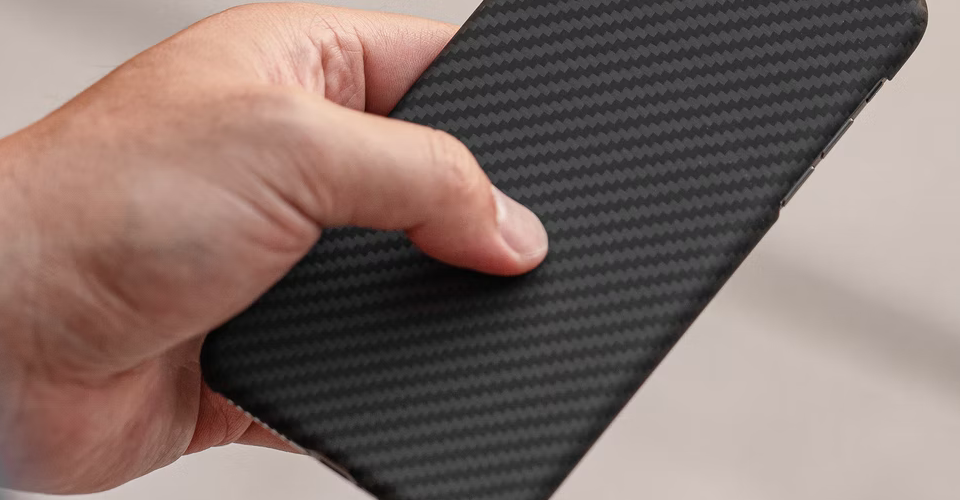Top 5 Best 3D Printing Carbon Fiber Filaments
3D printed objects are not exactly known for being durable, but there are a few filaments that are designed to emphasize mechanical strength. Examples include Polycarbonate (PC), Polyether ether ketone (PEEK), and Polyether Imide (PEI). The problem is that these filaments are quite expensive and are notoriously difficult to deal with.
Carbon fiber filaments provide a middle-ground for 3D printing durable objects at a lower level of difficulty. These are composite filaments that can have a range of different base plastics including PLA, ABS, or PETG. Check out some of our recommendations for the best carbon fiber filaments available today.
Top 5 best carbon fiber filaments
1. OVERTURE Carbon Fiber PLA Filament
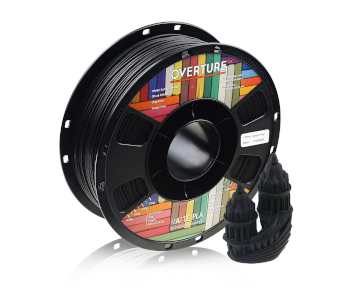
Simplicity is best when it comes to fancy filaments like carbon fiber, so we are partial with this PLA-base carbon fiber filament from Overture. The great thing about this combination is that the carbon fiber masks the lack of mechanical strength of PLA, while PLA makes the filament a lot easier to print with. If you have never used carbon filament before, then this would be a good filament to start with.
Another advantage of the Overture PLA-based carbon fiber is that it’s only a little more expensive than standard PLA. This is a lot cheaper compared to the other carbon fiber filaments on this list.
One thing to keep in mind is that the presence of carbon fiber cancels out the biodegradable characteristic of PLA. Carbon fiber is a material that practically lasts forever. If you’re concerned about contributing to the planet’s solid waste problem because of 3D printing, then carbon fiber filament is definitely not for you.
2. 3DXTech CarbonX Carbon Fiber ABS
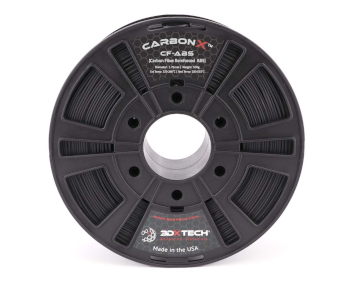
The CarbonX line of filaments from 3DXTech is well-known as the standard when it comes to carbon fiber filaments. Their filaments are top-tier when it comes to strength, abrasion resistance, and overall performance. Combined with ABS, this carbon fiber filament also benefits from added thermal and chemical stability.
Despite all these merits, the CarbonX filament simply isn’t one that we can recommend to beginners. Aside from the fact that it’s very expensive, this filament is also very finicky.
All the usual complications of working with ABS are still there, including the extremely unpleasant smell during printing. The rigidity of carbon fibers helps temper the filament’s tendency to warp, but you are still going to print on a heated bed and inside an enclosure.
If you do manage to get it to work, you will find that this is probably one of the best filaments you have ever used. Finished prints are very strong and look great.
3. PRILINE Carbon Fiber PETG
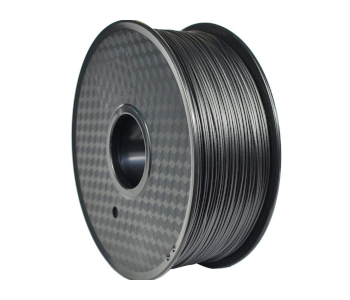
If you prefer a bit of thermal resistance in your carbon fiber prints, the best choice would be this PETG-based filament from Priline. As is often said about PETG, it combines all the best traits of PLA and ABS. It’s strong, can withstand higher temperatures, but is not prone to warping. The presence of carbon fibers only serves to accentuate these advantages.
When printed, this carbon fiber filament creates a gorgeously matte black finish. This looks great in car or household fixtures. With the innate heat stability of PETG, prints made with this filament can be left inside a car on a hot day and not become deformed.
The carbon fiber PETG filament is significantly more expensive than standard PETG at close to $50 for a 1-kilogram spool. You may have to dial in those settings very carefully to avoid wasting too much filament. In terms of quality and performance, this price tag is well justified.
4. Suntop Carbon Fiber PLA
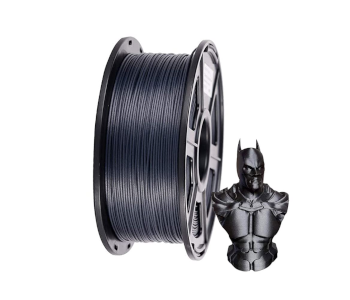
This is another version of a PLA-based carbon fiber filament from the Suntop brand. It promises many of the same claims as the Overture version such as better mechanical strength and rigidity compared to PLA. Perhaps the most notable difference would be the fact that this filament costs a few dollars more.
Finished prints made from the Suntop carbon fiber PLA filament look great with a matte black finish. The rigidity of carbon fibers cancels out any chances of distortion and shrinking, which is great for dimensional accuracy.
Perhaps the biggest challenge of working with the Suntop carbon fiber filament is the lack of flexibility of the filament. It is very brittle, and you’re bound to have a snapped filament at some point. Layer to layer adhesion is also somewhat diminished by the presence of carbon fibers, but you can make up for this with a higher printing temperature.
5. eSun Carbon Fiber Filled Nylon Filament
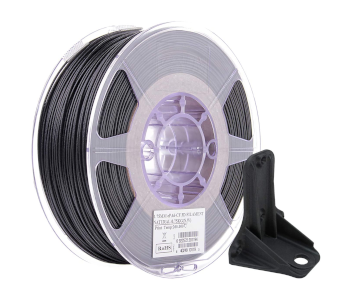
Combining Nylon and Carbon Fiber sounds like a good idea just because these are two already excellent materials. The idea does stand true if we look at this nylon-based carbon fiber filament from eSun. However, this is another filament that should come with a warning label that it can be very difficult to work with.
In terms of the quality of the finished print, this filament is impeccable. The use of nylon with carbon fiber yields an excellent combination of strength, rigidity, and flexibility. This is a combination of two industrial materials with very high strength-to-weight ratios.
However, 3D printing with this filament can be very challenging. You will have to deal with warping, poor bed adhesion, stringing, and handling a brittle filament. There’s a bit of a learning curve to using this filament properly, but the results are worth the effort.
What makes carbon fiber filament so special?
Carbon fiber filament is just one type of composite filament that is common in 3D printing. This means that it is made of solid particles suspended in a plastic matrix.
In contrast to other composite filaments, carbon fiber filament can have a base material that is not just PLA. Typical carbon fiber filaments can have a base plastic made of either PLA, ABS, Nylon, or PETG. This has a direct effect on the chemical and mechanical properties of the finished product, as well as the ease with which the filament can be printed.
The central components of this filament, of course, are the carbon fibers. These are very thin (about 5 to 10 micrometers in diameter) fibers that are composed of carbon atoms bound together in a crystalline structure. Layers of these are stacked together, with each layer forming bonds to the ones next to it. The result is a structure that is flexible, lightweight, compact, chemically stable, and has a very high tensile strength.
These benefits also translated to 3D printed products and also to the 3D printing process. Carbon fiber products have very good resistance against abrasion, corrosion, and chemical degradation. They have a higher strength-to-weight ratio compared to more traditional industrial materials such as wood, steel, or aluminum.
Compared to PC or PEEK filament, carbon fiber filaments are a lot easier to work with. They basically take on the printing performance of the base plastic. In the case of PLA and PETG-based filament, they are exceptionally resistant to warping. The mechanical strength of the carbon fibers also helps in maintaining dimensional stability.
A major drawback of carbon fiber filament is that it’s significantly more expensive than the average 3D printing filament. Compared to PLA, ABS, or PETG, carbon fiber filament typically costs twice as much.
Tips on printing with carbon fiber filament
Working with carbon fiber filament isn’t particularly difficult, but you may need to tweak your 3D printer’s hardware and settings a bit to get the best results. Here are some tips to start:
Use a hardened steel nozzle
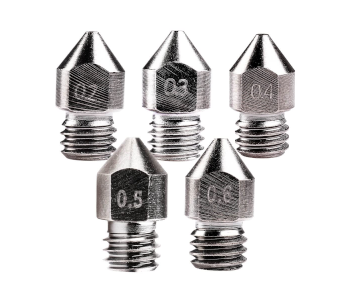
As with any composite filament, the carbon fibers embedded in the filament can quickly wear down a brass nozzle. This is particularly problematic in carbon fiber filament – carbon fibers are exceptionally strong, after all.
To avoid having to replace a brass nozzle frequently, the best option would be to replace it with a hardened steel nozzle. They are not expensive – this set of five nozzles from Creality costs less than $10.
Use nozzles with larger diameters
Another potential complication of using carbon fiber filament is that the carbon fibers tend to cause clogging of the nozzle. This is more likely to happen should you print while retraction is activated. To avoid clogging, you can either disable retraction or just print with a nozzle that has a larger opening. Using a nozzle with a diameter of 0.6 to 0.8 millimeters is recommended.
Print at low speed
Printing with carbon fiber filament can be quite taxing for your 3D printer’s extruder gears. The carbon fibers may be too strong for your extruder or idler gears to pinch and move forward. The typical result of this is that they cannot sustain very high extrusion rates.
Using a low printing speed places less stress on the extruder. If you are printing with a carbon fiber-infused PETG filament, it would be a good idea to print at a speed that is 50% lower than the usual printing speed for pure PETG. From this setting, you can inch the speed up until you reach a setting that you’re satisfied with. At the most, you can go up to around 75% of the usual printing speed.
Evaluate the filament path
Just as with any composite filament, carbon fiber filament is a lot more brittle than pure PLA, PETG, or ABS. If the path for the filament requires a lot of bending, a carbon fiber filament will very likely just snap.
When printing with carbon fiber filament, it is good practice to make the filament path as smooth as possible. Avoid having the filament go through sharp turns or bends. This might involve having to relocate your filament spool entirely.
Getting good prints typically is not the issue when it comes to carbon fiber filament. What you should be more concerned with is how the filament can mess up your 3D printer in terms of clogging and wearing out of nozzles if you aren’t careful.
Final thoughts
Printing with high-performance filaments like PC and PEEK is something that you should attempt at some point, but it’s going to take some experience and a lot of frustration. If that’s not a level you’re aspiring to just yet, you can make do with any of these carbon fiber filaments.
The great thing about carbon fiber filaments is that they do not necessarily have to be PLA-based. This means that you have more options when it comes to print performance and quality. Printing with carbon fiber filament is still challenging, but you can handle it with some trial and error.

